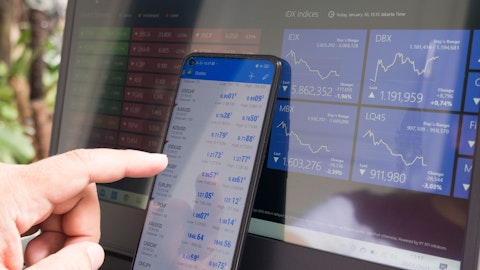Nokia Oyj (NYSE:NOK) Q1 2024 Earnings Call Transcript April 18, 2024
Nokia Oyj isn’t one of the 30 most popular stocks among hedge funds at the end of the third quarter (see the details here).
David Mulholland: Good morning, ladies and gentlemen. Welcome to Nokia’s First Quarter 2024 Results Call. I’m David Mulholland, Head of Nokia Investor Relations. And today, with me is Pekka Lundmark, our President and CEO; along with Marco Wiren, our CFO. Before we get started, a quick disclaimer. During this call, we will be making forward-looking statements regarding our future business and financial performance, and these statements are predictions that involve risks and uncertainties. Actual results may therefore differ materially from the results we currently expect. Factors that could cause such differences can be both external as well as internal operating factors. We have identified such risks in the Risk Factors section of our annual report on Form 20-F, which is available on our Investor Relations Web site.
Within today’s presentation, references to growth rates will mainly be on a constant currency basis. On margins, we’ll be referring to our comparable reporting. Please note that our Q4 report and the presentation that accompanies the call are published on our Web site. This report includes both reported and comparable financial results, and a reconciliation between the two. In terms of the agenda for today, Pekka will go through the key messages from the quarter, Marco will go through the financial performance in a bit more detail, and then Pekka will make a few comments on a couple of particular highlights in the quarter. And we’ll then move to Q&A. With that, let me hand over to Pekka.

Pekka Lundmark: Thanks, David, and thank you all for dialing in today. We said, back in January, that we expected a challenging environment in the first-half of this year, and that’s what we saw in Q1. Our net sales declined 19% year-on-year in constant currency as the weak spending environment, that started to take hold in Q2, last year, remained with us. This impacted the profitability of our three networks businesses, but was offset by the benefit of deals signed in Nokia Technologies, and the ongoing cost reductions. Marco will go into more detail shortly about our financial performance in the quarter. You may also recall that we started to talk about improved order intake trends in Q4, particularly in our Network Infrastructure business.
I’m pleased to say that this has continued in Q1. We have seen good growth in order intake year-on-year, and the book-to-bill in Network Infrastructure was above one. The outlook for Fixed Networks has improved over the past three months, which is important as this is often the market that recovers first in our business. However, it might take somewhat longer for our Optical Networks business to recover. With the continued order intake strength, I remain confident that we will see a stronger second-half performance and that, for the full-year, our Network Infrastructure business will return to growth. We have also been executing quickly on our cost reduction program, where we target to achieve between €800 million and €1.2 billion in cost savings by 2026.
We are well on track with many actions already taken in Q4 and Q1 to achieve the total €500 million of in-year savings in 2024. €400 million of this relates to the new program we announced in October. One of the biggest highlights from Q1 is the three smartphone licensing deals that we signed. I’m delighted we have now concluded our smartphone licensing renewal cycle, and we’ll have no more major renewals for a number of years. With these deals, we now have an annual net sales run rate of approximately €1.3 billion in Nokia Technologies. We have also benefited from over €400 million of catch-up net sales in the quarter related to these deals. Nokia Technologies’ team will now focus their efforts on expanding in new growth areas, and we have a promising pipeline to help us deliver on our next target to increase our run rate to €1.4 billion to €1.5 billion in the mid-term.
See also 30 Countries with Carbon Tax in the World and 19 Best Alternatives to Discord in 2024.
Q&A Session
Follow Nokia Corp (NYSE:NOK)
Follow Nokia Corp (NYSE:NOK)
Finally, we saw strong free cash flow generation in the quarter with almost €1 billion of free cash flow. Along with the benefits in operating profit that we saw from the deals signed in Nokia Technologies, we have also seen some unwind of the working capital investment we made over the past two years related to the supply chain challenges and some growth opportunities we had. So, overall, the first-half of 2024 will remain challenging in our networks businesses, but with the improving order trends, progress made in Nokia Technologies, and our quick action on cost, we remain solidly on track to achieve our full-year outlook. With that, let me hand it over to Marco to go through the financial performance in more detail.
Marco Wiren: Thanks, Pekka, and good morning from my side as well. As mentioned, we saw a weak start of ’24, with a 19% decline in our net sales as the challenging environment of the second-half of ’23 remained with us. Our gross margin improved significantly year-on-year, to 48.6%, and this is due to a combination of an improved gross margin in Mobile Networks, and deals we signed in Nokia Technologies. Our operating margin also benefited from these deals, which offset [overall] (ph) profitability in our networks businesses. Free cash flow generation was strong in the quarter as a result of the Nokia Technologies catch-up payments and working capital improvements. This means that we ended the quarter with a net cash balance of €5.1 billion.
And I will now take you through the individual performances of the business groups. And in Network Infrastructure, sales declined by 26%, compared to a very strong year-ago quarter where we still benefited from supply chain catch-up. I would also call out that, in the quarter, we saw a 23% year-on-year decline in Submarine Networks. And this was related to a project timing, along with some destruction, given ongoing Red Sea conflicts. We continue to sign new deals that increase our backlog in submarine. Gross margin declined slightly because of lower net sales coverage and less favorable business mix, and this flowed through to operating margin. As Pekka highlighted, order trends improved again in the quarter, which gives continued confidence that Q1 will mark the low point from a net sales perspective, and that the business will see stronger trends into the second-half of ’24.
This is supporting the assumption that Network Infrastructure will return to growth on a constant currency basis in full-year ’24. And turning to Mobile Networks, as you recall, our first-half of ’23 was driven by significant 5G deployments in India that then started to normalize in the second-half of last year. And this means that we face a very challenging comparison in the first-half of this year. And this, combined with ongoing low levels of activity in North America led to a 37% net sales decline in the quarter. We do expect that quarter one will represent the low point of net sales in both India and North America in ’24. We saw a strong increase in gross margins, which was 42.4% in the quarter. And half of that year-on-year increase was the result of positive regional and product mix, and the remainder was due to exceptionally low indirect cost of sales, which we expect to normalize going forward.
Operating margin declined due to low net sales coverage. And Cloud and Network Services also saw a soft start of the year, but we are seeing improving order intake and pipeline momentum also in this business. And our full-year assumptions remain unchanged. Gross margin increased by 310 basis points in the quarter thanks to a favorable product mix and regional mix. Operating margin declined compared to prior-year due to a lower net sales coverage. And as a reminder, in quarter four, we announced the sales of our Device Management and Service Management businesses to Lumine. And this transaction has now closed, and will have a modest impact on CNS in quarter two, and onwards. To give you some context, the business was generating more than €100 million of annual sales, with good profitability.
And then briefly on Nokia Technologies, we were very pleased to see the conclusion of the smartphone renewal cycle, which brought with it over €400 million in catch-up payments in the quarter. And this increased our run rate from €900 million to €1 billion, which we had at the end of quarter four, to €1.3 billion we currently have. And now, the next goal is to increase our licensing net sales run rate to between €1.4 billion to €1.5 billion in the mid-term as we grow in the other areas that Pekka will explain later. And then the regional picture was, as expected, with significant decline in India, which had completed a large deployment in ’23. Similarly, the North American decline reflected continuation of low levels of deployment that we saw during the second-half of ’23.
And elsewhere, we largely saw declines in most regions, reflecting the ongoing weak market environment, while we continued to see growth in Middle East and Africa. And finally, on cash, you can see from the chart here that the dual impact of the catch up payments in Nokia Technologies and the release of working capital led to generation of almost €1 billion of free cash flow. We also reduced the level of sale of receivables in the quarter. And we therefore ended the quarter with €5.1 billion net cash and are on track to achieve our targeted free cash flow conversion of 30% to 60%. And with that, let me hand you back over to Pekka.
Pekka Lundmark: Thank you, Marco. Firstly, I want to touch on Fixed Networks. We are the market leader with over 40% market share globally excluding China in OLT products. With our product portfolio and the ability to offer customers a roadmap to deploy X GPON, XGS-PON, and 25G PON in the same line card, we have a compelling value proposition. Customers can also upgrade to 50G and 100G in the same chassis down the line with our Lightspan MF-14 platform. We also launched new ONT products for 25G in the first quarter. These ONTs support both business as well as residential applications. Looking then at market dynamics, it’s important to remember that globally excluding China over 70% of homes are still not connected by fiber and there is a significant opportunity remaining in our biggest markets of both North America and Europe.





